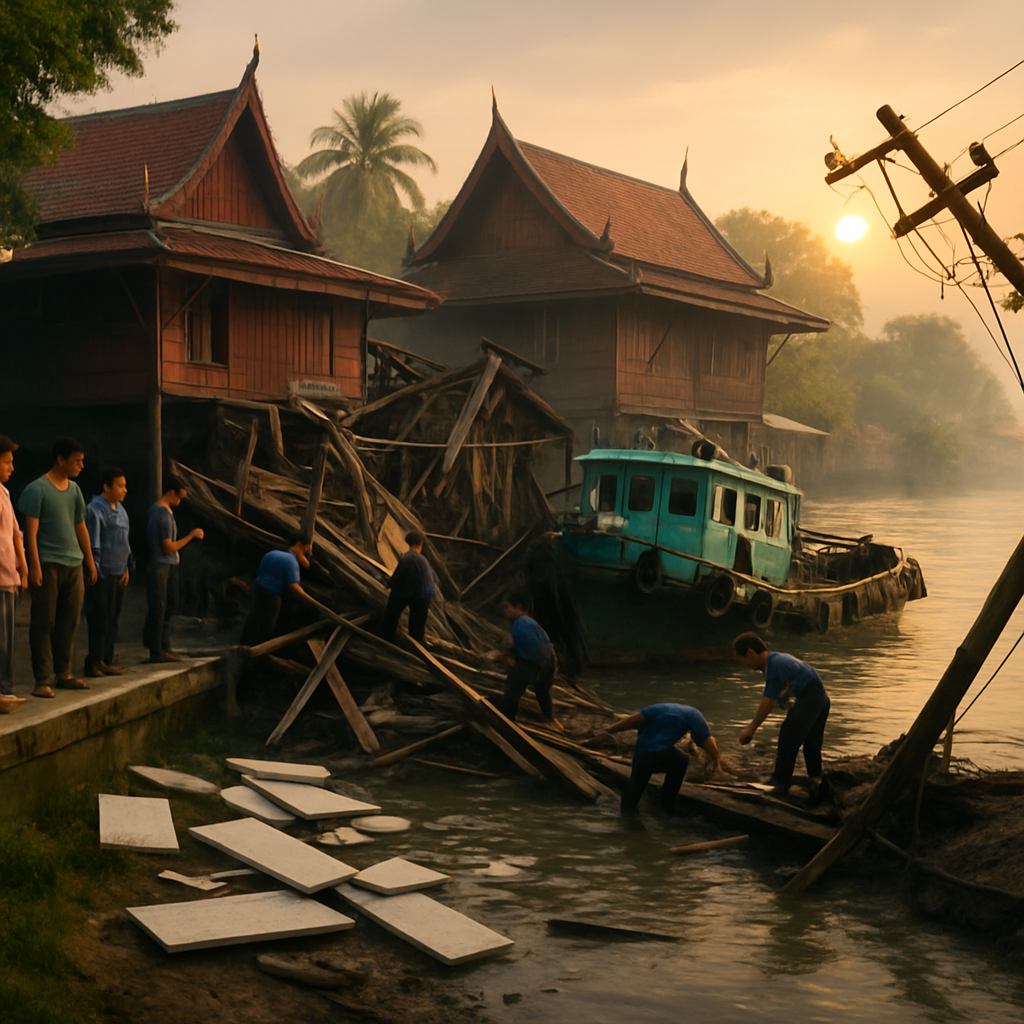In the quiet hours of the morning on November 18, a loaded tugboat lost control and smashed into three riverside homes along the Chao Phraya River in Koh Kret, Pak Kret district, Nonthaburi — leaving a trail of mangled wood, fallen power lines and stunned residents. The vessel, reportedly carrying more than 5,000 tonnes of gypsum boards, struck houses numbered 27, 27/1 and 27/2 at around 1:00 a.m., causing damage officials estimate at over 10 million baht.
Nighttime chaos on the Chao Phraya
Pak Kret Police arrived on the scene at about 5:00 a.m. and found severe structural damage to the riverbank properties. House 27/1 suffered the worst of the impact and partially collapsed into the river. A nearby power pole was toppled by the collision, plunging the sub-district into darkness and complicating early recovery efforts. Miraculously, there were no reported injuries.
Owner counts loss after late-night shock
The owner of the most badly damaged home, 66-year-old Phairat Rodjiam, told Channel 7 that he had recently invested more than 2 million baht renovating the property. With the house largely washed into the river, his total losses are now estimated to exceed 10 million baht. “I had just finished renovating,” Phairat said, visibly shaken. “Everything I put into that house — it’s all gone.” (Photos of the wreckage were shared by ThaiRath.)
What the tugboat operator says
The tugboat was being operated by 30-year-old Sakorn Makawan, who was transporting gypsum from Bang Pa-in district in Ayutthaya to Bangkok. According to Sakorn, the steering system malfunctioned as he navigated the river near Koh Kret. He told authorities that strong river currents pushed the vessel off course and into the homes. Sakorn also insisted he had not been drinking or fallen asleep at the wheel.
“My steering failed,” Sakorn said. “The current grabbed us before I could get control back.” He added that he is willing to meet with each affected family and wants to provide compensation. Phairat acknowledged Sakorn’s willingness to help but expressed uncertainty about whether Sakorn or his employer could fully cover the combined losses.
Legal fallout and next steps
Police have charged Sakorn under Section 420 of the Civil and Commercial Code for reckless behavior resulting in property damage. Authorities have begun documenting the scene and assessing the full extent of structural and infrastructure losses as discussions over compensation continue between the families, the tugboat operator and the company that owned the vessel.
While criminal and civil avenues are being pursued, the immediate priorities are safety and recovery: shoring up unstable structures, restoring power to the neighborhood after the fallen pole was removed, and helping displaced residents find temporary shelter. Local officials have also warned of environmental and navigational hazards as debris from the collapsed home and boat cargo scatters in the river.
Community reaction
Residents along the Chao Phraya and on Koh Kret expressed shock that such a dramatic accident occurred in a normally peaceful stretch of riverfront homes. For many, the area is a place of daily rituals — evening walks, fishing, morning markets — and the sight of a home smashed into the water feels surreal.
Neighbors say they are relieved that no one was hurt, but the financial and emotional fallout is significant. Phairat’s frustration centers not only on the loss of property but on the uncertainty of compensation. “I appreciate that he wants to help,” he said of Sakorn, “but can he or the company actually pay for everything that was lost?”
What comes next
Investigators will continue to examine the tugboat’s equipment and the circumstances that led to the steering malfunction. Authorities will also work to determine whether any additional safety or oversight failures contributed to the crash. In the meantime, compensation negotiations remain ongoing and residents seek reassurances that river traffic and cargo safety will be tightened to prevent another night like this.
This incident has served as a stark reminder that riverfront life, while picturesque, sits at the mercy of heavy commercial traffic. For now, Koh Kret’s residents are counting repairs, documenting losses and hoping for a fair settlement — and for the Chao Phraya to return to its usual calm.
Photos via ThaiRath. Reporting contributions from Channel 7 and local Pak Kret authorities.


















This is outrageous — a whole house washed away and they say the steering just failed. How many checks do these companies skip before sending big loads down a narrow river? The government needs to act now to prevent a repeat.
Act now? Easier said than done, Joe. Tightening regulations without proper funding only pushes costs onto smaller operators and might push more traffic into unregulated channels.
No one hurt so lucky. But my cousin’s house lost two roofs in a storm and he got nothing. Why should this be different?
Larry D, funding is the point — you make it sound like an excuse to do nothing. And grower134, compensation systems exist but they often favor companies, not older homeowners like Phairat.
Structural failures are one thing, but this reads like a systems failure: poor maintenance, risky routing, and possible overload of local enforcement. Section 420 charges may cover reckless behavior, yet corporate accountability seems thin. We need transparent investigations with public reporting.
Agreed — a proper forensic inspection of the steering mechanism and maintenance logs is essential. In maritime incidents, root causes often include deferred maintenance and inadequate crew training, not just a single mechanical failure.
Section 420 targets reckless behavior, but civil suits could drag in the vessel owner and insurer. The evidentiary chain (logs, cargo manifests, maintenance records) will be decisive in apportioning liability.
Why do big boats even go so close to houses at night? My dad says rivers were for small boats, not huge cargos. Someone should make rules to stop this.
Because big trucks go on big roads, big boats go on big rivers. But people live there so maybe they need barriers or something.
Barriers could help, but river geometry and currents change with seasons. Engineering solutions exist, yet they require investment and long-term planning, which often stalls.
I’m worried about environmental damage from gypsum and debris. Broken boards and household waste in the river could harm fish and clog waterways. Cleanup must be prioritized alongside structural repair.
Exactly. I kayak that stretch weekly and already saw floating debris yesterday. If companies are allowed to route heavy cargo without strict cleanup plans, this will keep happening.
Thank you for worrying about the river. My house went into the water and the debris is everywhere — I don’t know how to fix the environmental damage and my losses are huge.
I live nearby and the late-night crash woke everyone up. We are relieved no one was injured, but our sense of safety is broken. How will we trust river traffic again if authorities just file a report and move on?
Somchai, same here — my family is scared to sleep with the river so close now. Temporary shelters are fine but they must also guarantee quick compensation so people rebuild.
I was the operator and I deeply regret what happened. The steering failed suddenly and the current pulled us; I am ready to cooperate and help the families as best I can.
I had just spent over 2 million baht renovating and it all went into the river overnight. I appreciate Sakorn saying he wants to help, but I need real guarantees that my losses will be covered. I want a fair settlement or legal action if needed.
Phairat, I’m so sorry. Small homeowners like you always get the short end. Demand transparency and don’t accept vague promises.
I am not making excuses — my steering failed and the current was strong. I did not drink and I did not fall asleep. I want to meet the families and do my best to provide compensation.
Sakorn, your willingness to help is noted, but it won’t replace a formal investigation and documentary proof of maintenance and training. Your employer and insurer must be involved.
Sakorn, if you truly want to help, push your company to disclose maintenance logs and get legal counsel. Individual offers look good on camera but rarely pay the full damages.
This incident raises questions about risk management for inland waterways. Operators should implement redundant steering systems and enforce crew competency. Regulators must mandate and audit these mitigations.
Redundant mechanical or hydraulic backups could prevent such outcomes, but retrofitting older tugs is costly. Still, the local risk profile suggests it’s justified for high-traffic corridors.
The cost-benefit analysis should account for social losses, too. Ten million baht of damage plus environmental and trust costs likely outweigh preventive investments over time.
My students are asking about this and it’s hard to explain why accidents like this happen when it could have been prevented. We should use it to teach civic responsibility and safety.
My dad says the river is scary now. I liked walking there for fish. They should put lights and nets or something so it doesn’t happen again.
Ten million baht is the headline, but indirect losses and market confidence effects can multiply that figure. Insurance coverage, liability distribution, and public expenditure for repairs will be debated for months.
Insurers will look for proximate cause, and if negligence is found, the operator and employer could face large payouts. But insurance disputes can drag on, leaving homeowners uncompensated in the interim.
People keep saying ‘systems failure’ but the reality is political will. Local officials let heavy traffic pass where old houses are still built. Who approved river lanes and patrol schedules?
Exactly — enforcement is patchy and the Chao Phraya is busier than ever. Planning should include clear lanes, speed limits, and nighttime restrictions for large cargoes.
From a legal standpoint, there will be three tracks: criminal charges against the operator, civil suits for damages, and administrative review of licensing and routes. Homeowners should document everything and seek counsel early.
We are documenting with photos and witness statements. But legal help costs money and we are not sure who will fund prolonged litigation.
I am collecting all receipts and photos, and I will pursue the case if needed. I don’t want charity, I want rightful compensation.
This stretch is picturesque but unsuitable for heavy cargos without buffers. Even if steering failed, routing and timing decisions put residential structures at unnecessary risk. It’s a policy failure as much as a mechanical one.
Policy must be informed by hydrology and community needs. Otherwise we keep imposing industrial throughput on fragile living spaces.
As an engineer, I see two immediate fixes: temporary revetments to protect remaining houses and a fast-track inspection of all tugs operating similar routes. Long-term, consider designated cargo channels separated from residential banks.
Revetments help in the short term but are not a panacea. Comprehensive hazard mapping and enforced vessel traffic schemes are also required for resilience.
People here are scared and tired of promises. I will not be calm until someone proves they will pay and my neighbors can sleep at night again.
Who is checking the tug company’s safety record? My kids go to the riverside market and I won’t let them go until I see stronger oversight. This isn’t just property damage; it’s public safety.
From reporters on the scene: authorities removed the fallen pole and are coordinating temporary shelters. Officials say investigations are ongoing but provided no timeline for compensation. We’ll update as documents become available.
ReporterThaiRath, thanks for the update. Please push for release of maintenance records and company statements — transparency will calm people more than vague promises.